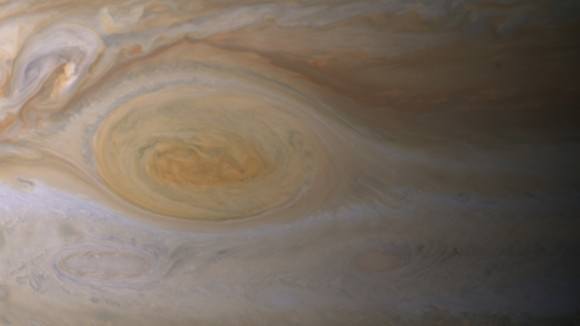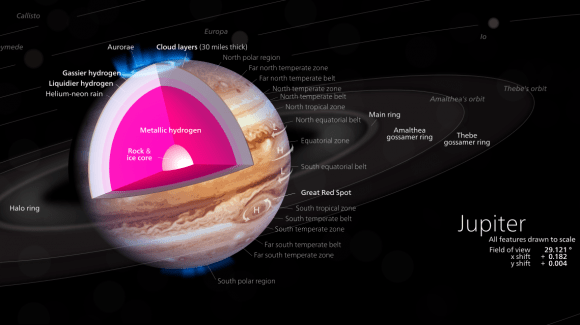Jupiter, which takes its name from the father of the gods in ancient Roman mythology, is the largest planet in our Solar System. It also has the most moon’s of any solar planet – with 50 accounted for and another 17 awaiting confirmation. It has the most intense surface activity, with storms up to 600 km/h occurring in certain areas, and a persistent anticyclonic storm that is even larger than planet Earth.
And when it comes to temperature, Jupiter maintains this reputation for extremity, ranging from extreme cold to extreme hot. But since the planet has no surface to speak of, being a gas giant, it’s temperature cannot be accurately measured in one place – and varies greatly between its upper atmosphere and core.
Currently, scientists do not have exact numbers for the what temperatures are like within the planet, and measuring closer to the interior is difficult, given the extreme pressure of the planet’s atmosphere. However, scientists have obtained readings on what the temperature is at the upper edge of the cloud cover: approximately -145 degrees C.
Because of this extremely cold temperature, the atmosphere at this level is composed primarily of ammonia crystals and possibly ammonium hydrosulfide – another crystallized solid that can only exist where conditions are cold enough.
However, if one were to descend a little deeper into the atmosphere, the pressure would increases to a point where it is ten times what it is here on Earth. At this altitude, the temperature is thought to increase to a comfortable 21 °C, the equivalent to what we call “room temperature” here on Earth.
Descend further and the hydrogen in the atmosphere becomes hot enough to turn into a liquid and the temperature is thought to be over 9,700 C. Meanwhile, at the core of the planet, which is believed to be composed of rock and even metallic hydrogen, the temperature may reach as high as 35,700°C – hotter than even the surface of the Sun.
Interestingly enough, it may be this very temperature differential that leads to the intense storms that have been observed on Jupiter. Here on Earth, storms are generated by cool air mixing with warm air. Scientists believe the same holds true on Jupiter.

One difference is that the jet streams that drive storms and winds on Earth are caused by the Sun heating the atmosphere. On Jupiter it seems that the jet streams are driven by the planets’ own heat, which are the result of its intense atmospheric pressure and gravity.
During its orbit around the planet, the Galileo spacecraft observed winds in excess of 600 kph using a probe it deployed into the upper atmosphere. However, even at a distance, Jupiter’s massive storms can be seen to be humungous in nature, with some having been observed to grow to more than 2000 km in diameter in a single day.
And by far, the greatest of Jupiter’s storms is known as the Great Red Spot, a persistent anticyclonic storm that has been raging for hundreds of years. At 24–40,000 km in diameter and 12–14,000 km in height, it is the largest storm in our Solar System. In fact, it is so big that Earth could fit inside it four to seven times over.
Given its size, internal heat, pressure, and the prevalence of hydrogen in its composition, there are some who wonder if Jupiter could collapse under its own mass and trigger a fusion reaction, becoming a second star in our Solar System. There are a few reasons why this has not happened, much to the chagrin of science fiction fans everywhere!

For starters, despite its mass, gravity and the intense heat it is believed to generate near its core, Jupiter is not nearly massive or hot enough to trigger a nuclear reaction. In terms of the former, Jupiter would have to multiply its current mass by a factor of 80 in order to become massive enough to ignite a fusion reaction.
With that amount of mass, Jupiter would experience what is known as gravitational compression (i.e. it would collapse in on itself) and become hot enough to fuse hydrogen into helium. That is not going to happen any time soon since, outside of the Sun, there isn’t even that much available mass in our Solar System.
Of course, others have expressed concern about the planet being “ignited” by a meteorite or a probe crashing into it – as the Galileo probe was back in 2003. Here too, the right conditions simply don’t exist (mercifully) for Jupiter to become a massive fireball.
While hydrogen is combustible, Jupiter’s atmosphere could not be set aflame without sufficient oxygen for it to burn in. Since no oxygen exists in the atmosphere, there is no chance of igniting the hydrogen, accidentally or otherwise, and turning the planet into a tiny star.
Scientists are striving to better understand the temperature of Jupiter in hopes that they will eventually be able to understand the planet itself. The Galileo probe helped and data from New Horizons went even further. NASA and other space agencies are planning future missions that should bring new data to light.
To learn more about Jupiter, check out this article on how weather storms on Jupiter form quickly. Here’s Hubblesite’s News Releases about Jupiter, and NASA’s Solar System Explorer.
We’ve also recorded an entire show just on Jupiter for Astronomy Cast. Listen to it here, Episode 56: Jupiter, and Episode 57: Jupiter’s Moons.
Sources:
http://solarsystem.nasa.gov/planets/profile.cfm?Object=Jupiter&Display=OverviewLong
http://www.jpl.nasa.gov/news/news.cfm?release=2008-013


I enjoyed this website. I am doing a project on Jupiter and this is giving me good resources to find my information. Thanks for this website! I appreciate that!
thank you!!!! as i am also doing a project on jupiter i also very much appreciate this data.